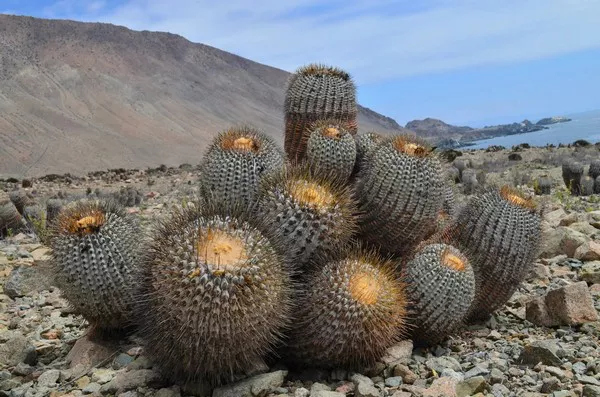In the arid landscapes of the world, where water is scarce and temperatures soar, one group of plants has evolved to thrive against all odds: cacti. With their striking forms, resilient nature, and remarkable adaptations, cacti have fascinated botanists, horticulturists, and nature enthusiasts for centuries. Among the diverse array of cactus species, one stands out for its unparalleled uniqueness, capturing the imagination with its extraordinary features and adaptations. In this article, we delve into the world of cacti to unveil the most unique among them, shedding light on its distinctive characteristics and the marvels of plant evolution.
The Story of the Most Unique Cactus:
Amidst the vast expanse of desert landscapes, where life clings tenaciously to every available niche, the story of the most unique cactus unfolds. Found in the rugged terrain of the Atacama Desert in Chile, the Copiapoa cinerea stands as a testament to nature’s ingenuity and resilience. This extraordinary cactus, known by its common name “Copiapoa,” has captured the fascination of botanists and plant enthusiasts worldwide for its remarkable adaptations to its harsh environment.
Origins and Habitat:
The Atacama Desert, often dubbed the driest place on Earth, stretches along the Pacific coast of South America, spanning parts of Chile and Peru. Within this barren landscape, where rainfall is virtually nonexistent and temperatures fluctuate dramatically, the Copiapoa cactus has carved out its niche. Endemic to the coastal regions of northern Chile, Copiapoa cinerea thrives in the rocky, arid terrain of the Atacama Desert, where it faces relentless sun exposure and extreme fluctuations in temperature.
Distinctive Features:
What sets the Copiapoa cactus apart from its desert-dwelling counterparts is its unique morphology and adaptations. Unlike many cacti species known for their towering columns or branching arms, Copiapoa cinerea assumes a low-growing, clumping habit, forming dense clusters of spherical stems. These stems, covered in a thick layer of woolly spines, serve as reservoirs for water storage, enabling the cactus to survive extended periods of drought. Additionally, the Copiapoa cactus exhibits a striking bluish-gray coloration, providing camouflage against the sun-bleached rocks of its habitat.
Remarkable Adaptations:
To thrive in the unforgiving environment of the Atacama Desert, the Copiapoa cactus has evolved an array of remarkable adaptations. One such adaptation is its ability to withstand extreme fluctuations in temperature, ranging from scorching daytime highs to near-freezing nighttime lows. By minimizing water loss through specialized tissues and employing efficient mechanisms for heat dissipation, the Copiapoa cactus maintains its physiological functions even in the harshest conditions.
Furthermore, the Copiapoa cactus has developed a unique symbiotic relationship with certain species of birds, which rely on the cactus for nesting sites and shelter. In return, these birds, such as the elusive Diuca finch, aid in the dispersal of the cactus’s seeds, facilitating its reproduction and dispersal across the desert landscape. This mutually beneficial interaction highlights the interconnectedness of desert ecosystems and the vital role played by cacti in supporting biodiversity.
Conservation Status and Threats:
Despite its resilience and adaptability, the Copiapoa cactus faces numerous threats to its survival, primarily due to human activities and habitat degradation. The expansion of mining operations, urban development, and illegal collection for horticultural trade pose significant challenges to the conservation of this unique species. Additionally, climate change and extreme weather events exacerbate the vulnerability of the Copiapoa cactus, disrupting its delicate ecological balance and further endangering its populations.
To address these threats and safeguard the future of the Copiapoa cactus, conservation efforts are underway, including habitat restoration initiatives, protected area designation, and community-based conservation projects. By raising awareness about the importance of preserving the unique biodiversity of the Atacama Desert and implementing sustainable management practices, stakeholders can work together to ensure the long-term survival of this extraordinary cactus species.
Cultural and Scientific Significance:
Beyond its ecological importance, the Copiapoa cactus holds cultural and scientific significance for the people of Chile and the global scientific community. Indigenous communities, such as the Atacameño people, have long revered cacti like Copiapoa for their medicinal properties, spiritual significance, and role in traditional ceremonies. Moreover, botanists and researchers view the Copiapoa cactus as a living treasure trove of genetic diversity and evolutionary adaptation, offering valuable insights into the mechanisms of plant survival in extreme environments.
In scientific circles, the Copiapoa cactus serves as a model organism for studying plant physiology, drought tolerance mechanisms, and the evolution of desert flora. By unraveling the genetic blueprint of this remarkable cactus species, scientists aim to unlock the secrets of its resilience and harness its adaptive traits for agricultural and environmental applications. Through interdisciplinary research and collaboration, the Copiapoa cactus continues to inspire discoveries and innovations that benefit society as a whole.
Conclusion:
In the harsh and unforgiving landscapes of the Atacama Desert, the Copiapoa cactus stands as a symbol of resilience, adaptability, and natural wonder. With its unique morphology, remarkable adaptations, and ecological significance, this extraordinary cactus species captivates the imagination and underscores the marvels of plant evolution. As we unravel the story of the most unique cactus, we gain a deeper appreciation for the intricate web of life that sustains our planet and the urgent need to protect and preserve its fragile ecosystems. Through concerted conservation efforts and sustainable practices, we can ensure that future generations continue to marvel at the beauty and resilience of the Copiapoa cactus and the diverse array of life it supports in the arid wilderness of the Atacama Desert.
You Might Be Interested In:



























